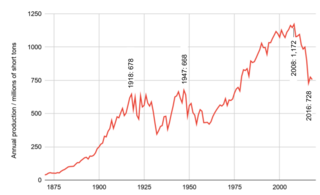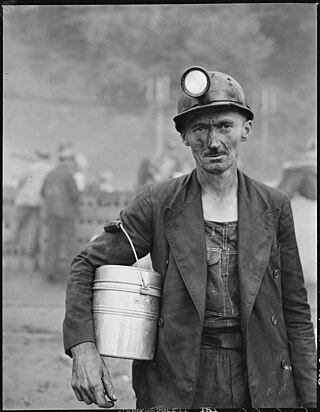
Paul Muni was an American stage and film actor from Chicago. He started his acting career in the Yiddish theater and during the 1930s, he was considered one of the most prestigious actors at the Warner Bros. studio and was given the rare privilege of choosing his own parts.

Centralia is a borough and near-ghost town in Columbia County, Pennsylvania, United States. It is part of Northeastern Pennsylvania. Its population has declined from 1,000 in 1980 to five residents in 2020 because a coal mine fire has been burning beneath the borough since 1962. Centralia, part of the Bloomsburg–Berwick metropolitan area, is the least-populated municipality in Pennsylvania. It is completely surrounded by Conyngham Township.

Roslyn is a city in Kittitas County, Washington, United States. The population was 893 at the 2010 census. Roslyn is located in the Cascade Mountains, about 80 miles east of Seattle. The town was founded in 1886 as a coal mining company town. During the 20th century, the town gradually transitioned away from coal, and today its economy is primarily based on forestry and tourism. The town was the filming location for The Runner Stumbles, Northern Exposure, and The Man in the High Castle. Many of the town's historical structures have been preserved, and its downtown was added to the National Register of Historic Places in 1978.

The United Mine Workers of America is a North American labor union best known for representing coal miners. Today, the Union also represents health care workers, truck drivers, manufacturing workers and public employees in the United States and Canada. Although its main focus has always been on workers and their rights, the UMW of today also advocates for better roads, schools, and universal health care. By 2014, coal mining had largely shifted to open pit mines in Wyoming, and there were only 60,000 active coal miners. The UMW was left with 35,000 members, of whom 20,000 were coal miners, chiefly in underground mines in Kentucky and West Virginia. However it was responsible for pensions and medical benefits for 40,000 retired miners, and for 50,000 spouses and dependents.

Michael Angelo Musmanno was an American jurist, politician, and naval officer. Coming from an immigrant family, he started to work as a coal loader at the age of 14. After serving in the United States Army in World War I, he obtained a law degree from Georgetown University. For nearly two decades from the early 1930s, he served as a judge in courts of Allegheny County, Pennsylvania. Entering the U.S. Navy during World War II, he served in the military justice system.

In the Lattimer massacre, at least 19 unarmed striking immigrant anthracite miners were killed violently at the Lattimer mine near Hazleton, Pennsylvania, United States, on September 10, 1897. The miners, mostly of Polish, Slovak, Lithuanian and German ethnicity, were shot and killed by a Luzerne County sheriff's posse. Scores more workers were wounded. The massacre was a turning point in the history of the United Mine Workers (UMW).

John Qualen was an American character actor of Norwegian heritage who specialized in Scandinavian roles.

The Molly Maguires is a 1970 American historical drama film directed by Martin Ritt, starring Sean Connery and Richard Harris. It is based on the 1964 book Lament for the Molly Maguires by Arthur H. Lewis.

Eckley Miners' Village in eastern Pennsylvania is an anthracite coal mining patch town located in Foster Township, Pennsylvania. Since 1970, Eckley has been owned and operated as a museum by the Pennsylvania Historical and Museum Commission.
The Coal and Iron Police was a private police force in the US state of Pennsylvania that existed between 1865 and 1931. It was established by the Pennsylvania General Assembly but employed and paid by the various coal companies. The origins of the Coal and Iron Police begin in 1865. Law enforcement in Pennsylvania at that time existed only on the county level or below; an elected sheriff was the primary law enforcement officer. The case was made by the coal and iron operators that they required additional protection of their property. Thus the Pennsylvania State Legislature passed State Act 228. This empowered the railroads to organize private police forces. In 1866, a supplement to the act was passed extending the privilege to "embrace all corporations, firms, or individuals, owning, leasing, or being in possession of any colliery, furnace, or rolling mill within this commonwealth". The 1866 supplement also stipulated that the words "coal and iron police" appear on their badges. A total of over 7,632 commissions were given for the Coal and Iron Police.

The Royal Mounted Rides Again is a 1945 Universal Pictures film serial. Actor and popular singing cowboy of the day Jack Randall died during the making of this serial.

A breaker boy was a coal-mining worker in the United States and United Kingdom whose job was to separate impurities from coal by hand in a coal breaker.

Hector William "Harry" Cording was an English-American actor. He is perhaps best remembered for his roles in the films The Black Cat (1934) and The Adventures of Robin Hood (1938).

Joseph A. Creaghan was an American film actor. He appeared in more than 300 films between 1916 and 1965, and notably played Ulysses S. Grant nine times between 1939 and 1958, most memorably in Union Pacific and They Died with Their Boots On.
John Barcoski was a Polish émigré miner brutally beaten to death by Pennsylvania's Coal and Iron Police on February 10, 1929. His passing and subsequent acquittal of his murderers on the first-degree murder charges provoked public indignation, which eventually led to the end of Pennsylvania's private anti-labor Coal and Iron Police system.

Black Fury is an historical novel by the American writer and judge Michael Musmanno. The novel was developed from his script for the 1935 film of the same name, Black Fury.

The history of coal mining in the United States starts with the first commercial use in 1701, within the Manakin-Sabot area of Richmond, Virginia. Coal was the dominant power source in the late 1800s and early 1900s, and although in rapid decline it remains a significant source of energy in 2023.

The Illinois coal wars, also known as the Illinois mine wars and several other names, were a series of labor disputes between 1898 and 1900 in central and southern Illinois.

People have worked as coal miners for centuries, but they became increasingly important during the Industrial revolution when coal was burnt on a large scale to fuel stationary and locomotive engines and heat buildings. Owing to coal's strategic role as a primary fuel, coal miners have figured strongly in labor and political movements since that time.
The Carbon County Strikes took place in Carbon County, Utah from 1903–1904. The strikes primarily consisted of Slavic and Italian immigrant mine workers who partnered with the United Mine Workers of America strikes in Colorado to protest the dangerous working conditions of the Utah coal mines. The Carbon County strikes were considered the most important labor confrontation in the United States at the time. The Utah Fuel Company strongly opposed initiatives to unionize coal workers in Utah and were the primary opposition to the UMWA at the time. The Carbon County Strikes would ultimately fail in its attempt to unionize the coal workers of Utah simply because it "did not have enough support, either internally or externally, to win against a powerful and influential company that effectively played on radical, anti-foreign sentiments in defending its position" but it demonstrated a significant nationwide effort in strengthening unionization in the west.

















